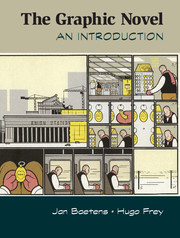Book contents
- Frontmatter
- Contents
- List of illustrations
- Acknowledgments
- 1 Introduction: The Graphic Novel, a Special Type of Comics
- Part One Historical Context
- 2 Adult Comics before the Graphic Novel: From Moral Panic to Pop Art Sensationalism, 1945–c.1967
- 3 Underground Comix and Mainstream Evolutions, 1968–c.1980
- 4 “Not Just for Kids”: Clever Comics and the New Graphic Novels
- Part Two Forms
- Part Three Themes
- Notes
- Index
3 - Underground Comix and Mainstream Evolutions, 1968–c.1980
Published online by Cambridge University Press: 05 October 2014
- Frontmatter
- Contents
- List of illustrations
- Acknowledgments
- 1 Introduction: The Graphic Novel, a Special Type of Comics
- Part One Historical Context
- 2 Adult Comics before the Graphic Novel: From Moral Panic to Pop Art Sensationalism, 1945–c.1967
- 3 Underground Comix and Mainstream Evolutions, 1968–c.1980
- 4 “Not Just for Kids”: Clever Comics and the New Graphic Novels
- Part Two Forms
- Part Three Themes
- Notes
- Index
Summary
This chapter continues the historical analysis of the development of the graphic novel in further chronological order by taking our narrative forward from the 1960s into the 1970s. In it we underline the role of the underground comix in changing the form and the creation of its first cultural star, Robert Crumb. While no clear notion of the graphic novel existed in the public mind for much of this period, one can very clearly put forward for discussion works that would be hugely influential on future creativity, such as Justin Green’s Binky Brown Meets the Holy Virgin Mary and Jaxon’s Comanche Moon. Equally, it is important to describe how the pioneer graphic novelists Will Eisner and Art Spiegelman were greatly influenced by the milieu of comix.
The chapter does not therefore propose any revisionism in the standard history of comics, and in fact we here recommend several important existing histories written by Jean-Paul Gabilliet, Charles Hatfield, Paul Lopes, Mark James Estren, and Patrick Rosenkranz. However, in its concluding paragraphs, we discuss how some parallel developments outside the world of the comix were also leading to the contribution of long-length, adult-focused comics quite similar to our present-day graphic novels (e.g., newspaper strips in collected editions by Charles Schulz and Garry Trudeau), and how in a corner of the sci-fi community there were also ambitions for longer, implicitly more literary works, which gave rise to insiders from this world labeling some works as graphic novels or the similar term “illustrated story.” By the end of the 1970s, there was no full consensus on when to use “graphic novel,” but in works such as Eisner’s A Contract with God: A Graphic Novel (1978) and Archie Goodwin and Walter Simonson’s Alien: The Illustrated Story (1979), people were producing and reading works with close relation to today’s publications.
- Type
- Chapter
- Information
- The Graphic NovelAn Introduction, pp. 54 - 73Publisher: Cambridge University PressPrint publication year: 2014



